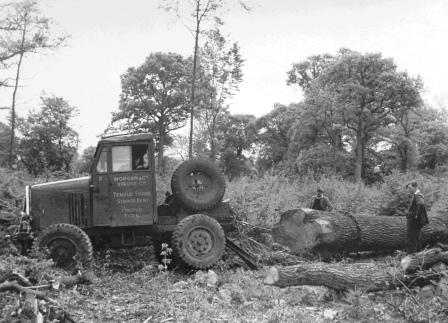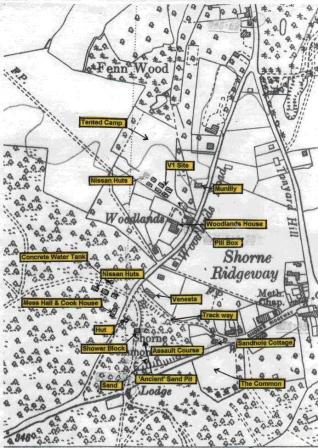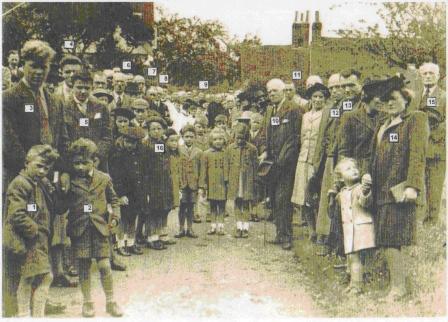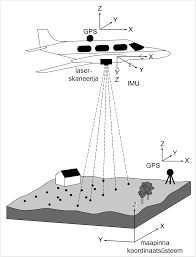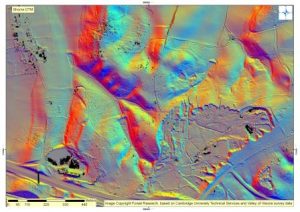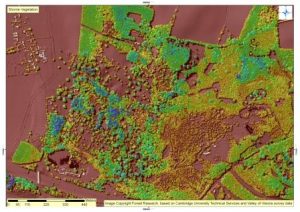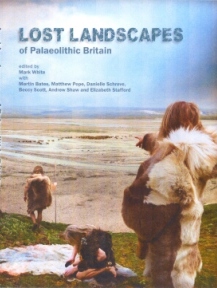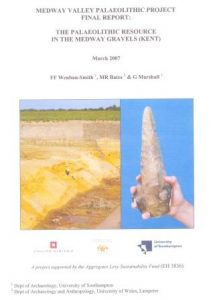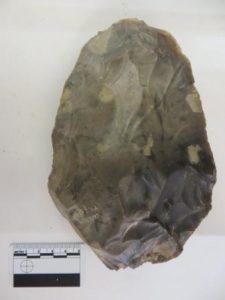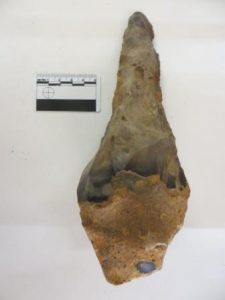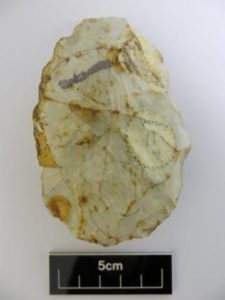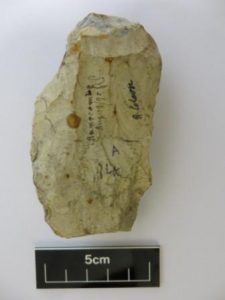First of all it is probably best if I begin by amplifying some of Reg’s memories with some of my own. We both lived near the woods and each of us was able to lean over the fence of our respective houses and be in contact with it.
The woods
I will explain my extremely early knowledge of the woods by describing my family size and structure. I was the youngest of ten children (born in 1927), six boys and four girls, my eldest brother was twenty two years older then me and the intervening years saw the births of the other eight and then finally myself. With a family of that size it was inevitable that the siblings looked after each other in the order of their ages. The two youngest of my brothers were seven and five years older then me and consequently from when I was about five years old where they went so did I, this gave me an extraordinary amount of freedom very early in my life.
During the 1930’s coppicing was big business with a number of men from the village working in the woods. It was quite strictly regulated, largely by the time it took for the trees to grow to the required height and the various cants were coppiced in rotation, as I remember it this was about every fifteen years.
At this time there was an old fellow who I knew only as ‘Jack the woodman’, he would buy the rights to one or two cants and arrive unheralded at our house to collect the first two large pails of water, these he carried on a wooden yoke. He came on a horse and wagon, towing a caravan which was similar to the old shepherd’s mobile huts (which they were able to move with the flock and live in reasonable comfort during the lambing season etc.). Jack would stay in the wood for a number of weeks and my mother purchased his food supplies from the numerous delivery men who called at our house, everything was delivered in those days.
Jack was quite happy for us boys to ‘help’ him and was a very patient man, I was able to learn a lot from him and how the various jigs he made worked. These were used to produce chestnut fencing in various heights to order and in approximately 10 to 12 feet in length.
Once the palings were ready to be used, the coppiced wood having been sawn to length, de-barked, quartered, the top trimmed to a point, they were piled next to a device, which I can only describe as looking like (and working on the same principal) a ‘camp loom’, they were then inserted between four wires, there being two a few inches in from each end of the paling. These were held in place by twisting the wire two or three times before the next paling was inserted and the wires twisted in the opposite direction, this was continued until the desired length of the fence had been reached.
When the larger trees in Randall Wood were being felled, in preparation for the start of the clay extraction, we spent quite a lot of time with the gangs of men working in the woods. To make a small but important point with regards to the felling of the trees, once the direction of the fall of the tree was decided a sizeable cleft was made with an axe, a long saw some 6 or 7 feet in length, was used (usually with an axe chip to locate the saw) on the other side of the tree all the way through the trunk, a wedge was driven into the saw cut to prevent the tree from rocking backwards and trapping the saw, fairly early on in the procedure and later, to help guide the tree as it fell. Virtually all the mature trees in the wood were either Sweet Chestnut or Sessile Oak.
The timber contractors that did the felling were Morgan’s of Strood, who were based on the Temple Farm Industrial Estate, they were operating at least until the late 1960’s when I was still living at Shorne. They were still using a rather ugly flat fronted cross between a lorry and a tractor which was the first four wheel drive and four wheel steering that I had ever seen and which they had been using in the woods since the 1930’s. Perhaps they might have some records of this.
The sand pit, mentioned by Reg Rootes, extended from the Ridgeway to a point opposite our house (our house is called ‘Venesta’) it was bounded by a track way that ran alongside our house and on the other two sides by The Ridgeway and another track known as Sandhole Drive which led from a point opposite the Woodlands Lane entrance to Randall Wood to a point opposite Pickle Hill lodge on The Ridgeway.
The sand pit was not the overgrown place it later became but a pleasant place of grass, bracken, bushes and mature Oak, Sweet Chestnut and some Silver Birch trees (almost all the Oak trees in the village were Sessle Oaks), we were able to look from our windows through the upper branches of the trees, to the woods on the other side, a very peaceful scene.
The Army moves in
When the two radio/radar towers were erected, early in the war, Thong Lane aerodrome was really active. There is a little article in the ‘Kent Airfields of the Second World War’ that gives some idea of what was happening. The towers were nearer to where Reg lived than they were to me, so he may know more about them than I do but I have marked on the map where I think they were.
While I was working on the farm at Thong (from early 1943 until late 1945) my route home took me past Boghurst Cottage at about 5pm every day. One day in 1943 I overtook a young WAAF struggling down Brewers Road carrying a two gallon jerry can (later on I discovered that this contained paraffin, used to heat their underground bunker). I offered to carry this for her and we made our way to the Tower via a gate almost opposite the entrance to Brewers Wood, halfway up Brewers Road and along a track at right angles to the road and directly to the tower. This first meeting led to the WAAF’s waiting for me at Boghurst to carry the can. The tower was located at a point where the track crossed the track leading from Woodlands Lane directly to Shepherds Gate (at the end of Halfpence Lane) and this location would have been overtaken by the clay workings.
The lookout known as ‘The Crows Nest’ was situated about fifty yards from the tower, we were told that this lookout was built by Lord Darnley to watch his sons cricket team come home up the Thames with the Ashes (about 1885 I think).
The first sign of the army moving into Woodlands Lane was that quite soon after Dunkirk. Three bren gun carriers drove down the track from The Ridgeway (this is now designated a footpath, then it was a cart track and provided a short cut for horse drawn traffic between The Ridgeway and Woodlands Lane or the woods and was frequently used as such) stopping outside our windows and were quickly inspected by yours truly while an officer reconnoitered. A few days later we woke up to the arrival of several, possibly six, large armoured vehicles with open cabs protected by only canvas hoods and with largish anti aircraft guns on the back. They were parked on what is now Shorne Common Rough on the eastern side of Woodlands Lane where they cut away the banks to provide access. These vehicles were visible from our windows and moved out each time a raid was threatened firing from any strategic point. They moved away at the end of the year but the army didn’t leave Woodlands Lane until after D. Day 1944.
The cart track leading from our house to Hanbury Cottages was used as a short cut by the army for a short time but stopped rather abruptly when a Humber staff car bounced off the roots of a large oak (just level with our kitchen window) and teetered on the edge of the sandpit until retrieved!
Early but vivid memories for me were the departure of my brother into the army, a week before war was declared, followed by the trauma of him being reported missing in action. Many anxious months following before we heard that he was a prisoner of war, where he stayed for the remainder of the war. I subsequently had two more brothers in the army, both served in the Far East and thankfully all three arrived home safely.
Another really vivid memory is of the hay harvest of 1940, my brother in law rented Thong Farm, which was then a dairy farm, I was 13 years old at the time and was helping him move the ‘rough’ on Cobham Golf Links for hay. When the majority of the hay had been stacked we loaded the wagon, tied the horse drawn mower on behind to transport back home to Thong, I had to lead the horse (18 hands) as my brother in law had cycled on ahead to prepare the cows for milking. At about the time I reached Brewers Gate, about 200 yards from Boghurst Cottage, there was a full scale air raid, the Cobham and Dillywood Lane guns were blazing away and shrapnel was zinging all around, at each explosion the horse reared up and I took a ‘white knuckle’ ride into the air, I was so relieved to arrive at Thong it could quite easily have been heaven.
At around this time I was repairing my bike outside our back door during an air raid when, fortunately my mum called me in for a cuppa, as I went in the door a fist sized piece of shrapnel hit my ‘tool box’, which was a Bluebird toffee tin, scattering my tools and shattering the tin, since I had been sitting on the ground with the tin between my knees I felt extremely lucky.
I don’t ever remember using an air raid shelter during the war, we didn’t possess one and we would often hear shrapnel landing on our roof. My sister who lived at No 1 Homewood Cottages on The Ridgeway had a Morrison shelter that occupied almost all of one of her downstairs rooms.
Leaving school
I left school in April 1941 and started working for A. K. Houghton, the village baker, as a rounds boy, it was around October in that year that I cycled home from work, in pouring rain and the dark (these were the nights of blackouts of course) without being challenged at the gate of Woodlands House. I cycled back down again about half an hour later in order to attend a talk on ‘Stirrup Pumps’ by the ARP Warden and in similar or worse conditions, again, confident that I wouldn’t be challenged. I was confronted by this dim figure shouting ‘Halt who g—–‘ before he could finish, I hit him and we landed on either side of the road, his tin hat had lacerated my right cheek and we were altogether not very happy with each other. After a few pleasant verbal exchanges I went on my way but my swollen face provided the basis for a whole series of witty conversations, amongst my customers, for a few weeks.
There was only a sentry at Woodlands House, I can’t remember there being a sentry at either end of Woodlands Lane or any where else near to home.
Another memory is that of having reveille played about 15 yards from my bedroom window every morning for months on end. The bugler (for some inexplicable reason) would stand at the bottom of the track way (now the footpath) in order to wake the whole of the camp. Fortunately, from 1943 I was working on a farm and was up and about before reveille was sounded but Sunday mornings – YUK!
The army regiments changed fairly often during the three years or so that Woodlands House was occupied by the army. During this time one of the regiments, I think the Durham Light Infantry, would match to church for the Sunday morning service and afterwards entertained the locals with pipes and drums in the space at the bottom of Butchers Hill, they had a very fast marching time, almost but not quite a trot!
Over the course of time, the size of the camp grew, the cookhouse and mess hall built (the concrete platform is still there, see map attached) along with other (mostly) Nissan Huts, including one on the opposite side of the road to the cookhouse and mess hall. A shower room was built in the middle of Sandpit Drive, some concrete is still visible there.
About a 100 yards or less, along the track from Woodlands Lane into the woods, there was a water reservoir, the remains are still visible today, it may have been for fire control or water storage for domestic use, there appears to have been no provision for sanitation otherwise.
It is a constant source of wonder to me that so many of the concrete bases for huts etc. have been absorbed by nature so quickly.
Just above the sign for ‘Venesta’ in the Cedar tree by the road, is or was recently, a solitary nail, the remaining one of the two which held wooden ‘cotton’ reels that carried the communication lines from Woodlands House (HQ) to the camp opposite our house.
In 1943 the Sand Pit was turned into an assault course with various rigs designed to make life difficult for those that had to use it. Ropes, trenches, barbed wire and climbing frames were the main obstacles, the sheer 25 feet face of the only remaining sand in the pit (the point nearest to Puckle Hill Lodge) and two leaps of 18 to 20 feet over the edge of the pit were all part of the course. We were able to observe this from our windows at home.
The assault course in the sandpit was quite a severe one but the most challenging aspects were the jumps over the edge, it was quite a jump into the unknown and to see the bottom some 20 to 25 feet below and to be expected to run hard at the edge and leap at full bore was frightening to newcomers, what they only learned later was that the landing was absorbed by a 40 degree slope from about six feet down so you never came to a sudden stop but slid down the last third or so of the drop, depending on your speed at take off, it often had the more timid recruits crying with fear. I broke my wrist in 1938 on one of these jumps, I was eleven years old.
For a month or two Woodlands Lane attracted a collection of ladies. In early 1944 three or more ENSA shows were organized and held in a Marquee on the Common. (It is now the Recreation Ground, after some extension towards the South West)
Not really relative to Shorne Woods but the aerodrome was extremely active and the farm that I worked on (Cheney’s Farm, Thong) had land around the ‘drome perimeter wire and so the aircraft in dispersal points were very close to where we were working. In early 1944, when the ‘drome was home to DH Mosquito’s, one of the aircraft failed a take off one afternoon and ploughed across a field killing two ladies who were planting potatoes, into a straw stack and finally stopping on the A2, covered in straw, the site of the stack yard, where the Service Station on the Rochester bound side of the A2 was eventually built.
A few days later I was ‘muck spreading’ on my own at around six am, in a field adjacent to the ‘drome perimeter wire, a burnt out Mosquito on the nearest dispersal, when I discovered almost 50 unexploded incendiary bombs littered around which I gathered together and piled up. I reported my find to the farmer at breakfast time, he passed on the information and they were later collected by the RAF.
Again only a few days later I saw the first indication of the great event of D. Day when the aircraft suddenly appeared over night, with black and white rings round the wings and fuselage. It was 6th June.
In May 1944 the army moved out leaving only four men to clear the camps, they were billeted in one of the three or four Nissan Huts built in a line along the side of a land way running towards the Scammals between Woodlands House and a house known to us as ‘Munnily’. (Woodlands House was demolished in the 1960’s and ‘Munilly’ renamed ‘Wood Lodge’). This move out did not convey too much to us as the regiments changed quite often, we later realized that this was preparation for D. Day.
The V1 doodlebug era was suddenly upon us and it was quite a frightening time, there were some that landed fairly close and they became quite a worry. On August 3rd one came down on the only occupied Nissan Hut, two of the soldiers were on leave that night and not in the hut but unfortunately the other two were killed. Although our house was some 200 yards further up Woodlands Lane, the window frame of my mothers bedroom was blown out and lying across her bed, apart from this there was little other damage except for some broken picture frames, odds and ends broken and of course broken glass.
There was a story that went round the village, probably apocryphal, that when the two soldiers arrived back at camp while the search for the missing soldiers was going on, they spent some time searching for themselves until they realized how lucky they had been!
That night I was on Home Guard duty and spent the night in and around an annex behind the ‘Leather Bottle’ in Cobham (wearing my own Ben shaped groove into the ground as a result of hitting the ground each time a V1 went over, they were particularly numerous and low that particular night). It wasn’t until I arrived at my sisters house, No. 1 Homewood Cottages, where my mother (very fortunately) was staying the night (my father had died in November 1943 so there were only two of us living at home) that I learned of the V1 tragedy. The wreckage of the Nissan Hut that was hit could still be seen the last time I looked in 2004. (I have since learned that Mr South, the owner of the land gave permission for the next door neighbour to tip the spoil from the swimming pool they were digging, to be deposited on the site and the Nissan Hut remains are now buried).
Reg (Reg Rootes) didn’t mention that Puckle Hill and a number of houses in Pondsfield Lane were taken over by the army for some years.
Mentioning earlier, the ‘early mornings’, the phenomenon of double British Summer Time during the war meant that we were actually starting work at between 03:30 and 04:00 hrs real time. This enabled us to work in daylight until 23:00 hrs DBST, (only 2100 hrs real time) during harvest times.
During the war the village scout troop, the 1st Shorne, 26th Gravesend, were given permission to use Brewers Wood over a wide area adjacent to Brewers Road and to within some 200 yards of the gardeners cottage, for camping and woodcraft. This was a highly advantageous agreement to both the troop and the estate as during this time no healthy trees were damaged but dead wood, undergrowth and paths were cleared. Other troops were invited and allowed to enjoy the woods, some care had to be taken to maintain blackout regulations and camp fires and sing songs were confined to daylight hours. Cooking could be managed by using ‘biscuit tin ovens’ and a tunnel like flu after dark but was seldom actually used. I remember these as being very pleasant days for us despite the war.
After the War
Woodlands House was used after the war to house service personnel returning from the war who were waiting for the provision of council houses as the huts, built for RAF in the woods at Shorne, Thong and Cobham, were used. Thankfully for them this did not last too long and most were re-housed in the early 1950’s. There are still people living in Shorne who were housed in Woodlands House and the camps. After the tenants were re-housed Woodlands House was either bought or rented by a Miss McKindoe who, it was said was the sister of Sir Archibald McKindoe the plastic surgeon, and she used the house for sufferers of cerebral palsy, she herself suffered very badly and found it difficult to speak.
In March 1946 I began work as a cowman (cowboy?) on the Court Lodge Farm with the ‘Maplesden Herd’ of Guernsey cows, I worked there until February 1947 when I left to join the Royal Naval Air Service, finally joining in July, after an operation. Since all the other employees were much older than me this probably makes me the last chap who milked a cow by hand in Shorne Village, the milking parlour was divided only by a footpath from the car park to the Rose and Crown. Morning milking was done by the light of hurricane lamps, most mornings at 05:30 hrs. I am also almost certainly the last man around to have made hay on what is now Warren View.
The photograph (below) was taken at Shorne School probably in the spring of 1940 judging by May Baker’s dress, Reg Rootes (now living in Higham), Les Webb, Peter Beech (still living in Thong, who’s family had a farm in Chalk), Ray Clark (who is still living in Meopham and who’s father farmed Racefield before and during the war) and myself. Ken McCady was an evacuee, Les Harold and Maurice all died some time ago.
The next photograph was taken outside Shorne Church on May 6th 1945 after a (slightly premature) thanksgiving service for the end of the war which I think was 8th May.
The names I can remember of people in the photograph are :
1: James (Jim) Hastie
(see comment below)
2 : Peter Hastie
3 : Ben Parish
4 : Alan Colenutt
5 : Lionel Colenutt
6 : Louis Vine (Parish Hall Secretary)
7 : Alwyn Light (Racefield Cottage)
8 : Frank Hollands (Farmer, Green Farm)
9 : Arthur Knight Houghton (Baker)
10 : Percy Baker (Thong House)
11 : Basil Houghton (Baker’s son)
12 : Gordon Houghton (Baker’s son, Farmer of Queens Farm)
13 : Frank Carpenter (A. K. Houghton’s son in law)
14 : Olive Houghton (A. K. Houghton’s daughter)
15 : Mr Hunter
16 : June Baber
(As told to Trevor Bent by Ben Parish 2010)

